This post may contain affiliate links. Please read our disclosure policy.
Authentic French Bouillabaisse is easy to make at home! Made with fennel, saffron, white wine, garlic, and plenty of seafood, this fragrant fish stew is a tried-and-true classic.
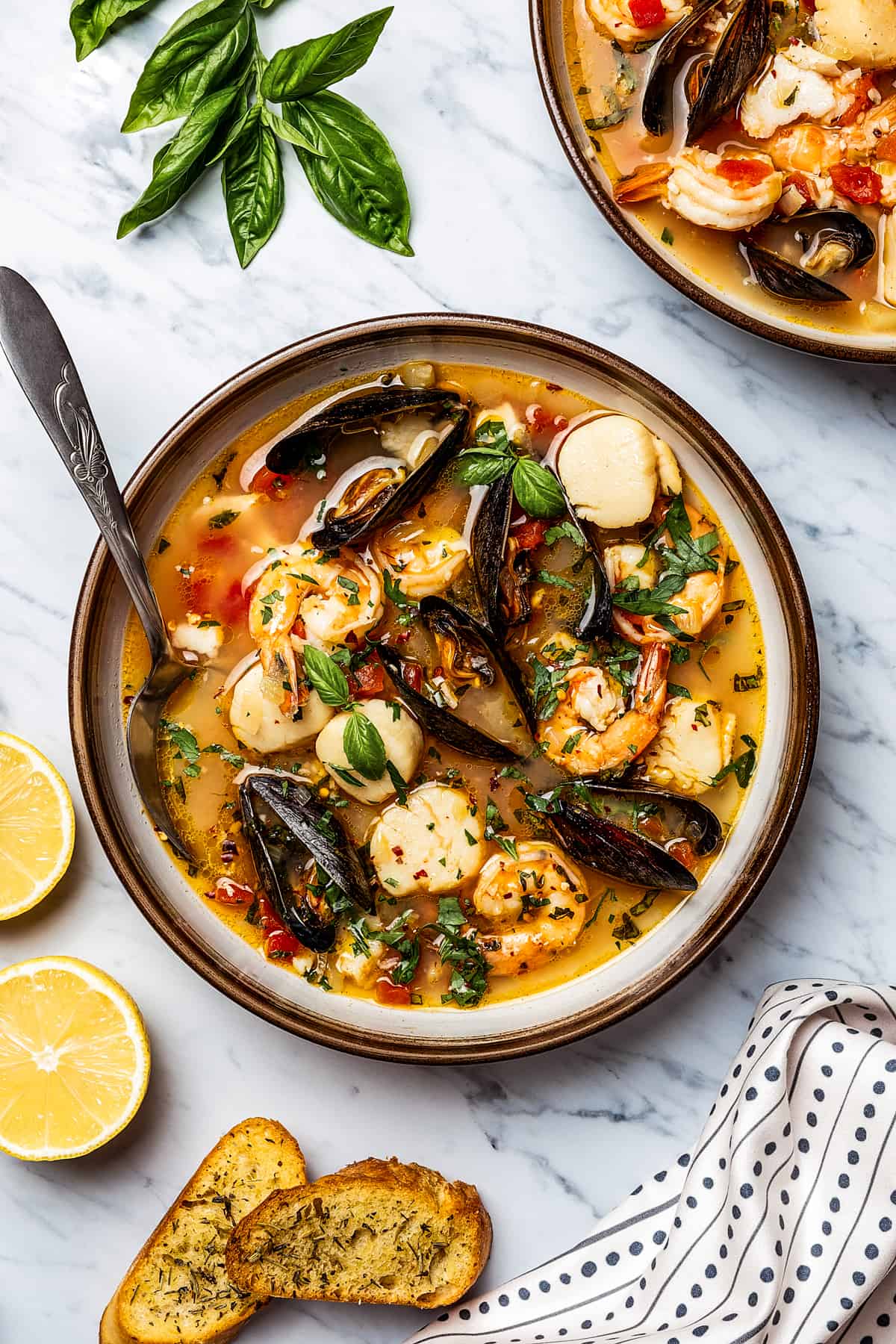
French Seafood Stew
Nothing is more satisfying than a bold, hearty, yet delicate dish of bouillabaisse served with crusty bread. This timeless Provençal fish soup, part of rustic French cuisine and popularized by the legendary Julia Child, showcases the freshest seafood. Traditionally, French cooks made this with various fish that were available at the time of cooking, along with a few shellfish. The irresistible broth gets its unique flavor from anise-flavored fennel, golden threads of saffron, and a splash of wine.
Making bouillabaisse might sound intimidating since it’s such a famous recipe and because we are cooking with saffron, but like many old recipes, it’s actually very simple. This authentic recipe will teach you how to make it yourself, and believe me, once you try it, there’s no going back!
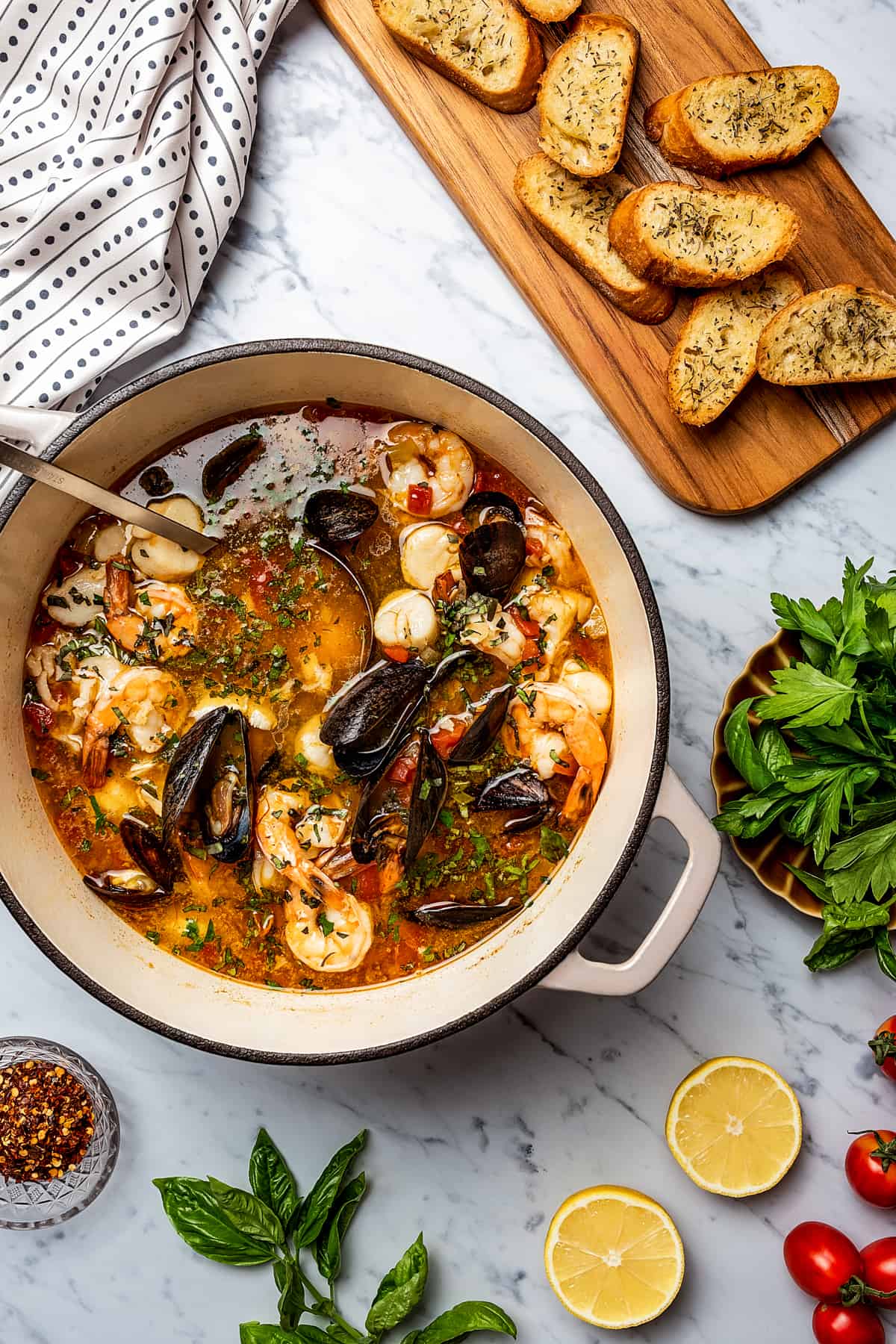
What Is Bouillabaisse?
Bouillabaisse is a traditional Provençal fish stew originating from the port city of Marseille, France. It’s a rich and flavorful dish made by boiling various types of fish, shellfish, and other seafood with herbs and spices in a broth made with tomatoes, onions, and leeks. This Mediterranean seafood dish is similar to another popular fish soup, cioppino – associated with Italian immigrant fishermen in San Francisco during the 1800s. Both use a variety of fresh seafood options, but cioppino tends to lean more heavily on shellfish, while bouillabaisse is more about the fish.

Bouillabaisse Ingredients
- Olive Oil and Butter: Using both adds a rich flavor.
- Fennel: Finely chop the fennel bulb. You can discard the stems or save them to make homemade broth.
- Onion: Dice up one yellow onion.
- Garlic: You’ll want a lot of garlic here, finely minced or pressed in a garlic press.
- Spices and Herbs: Dried thyme, paprika, saffron, bay leaves, salt, black pepper, and cayenne pepper.
- White Wine: Aim for a dry wine here, like a Sauvignon Blanc or Pinot Grigio.
- Clam Juice: Clam juice is easy to find in most grocery stores, next to canned tuna and other similar ingredients. However, if you have access to real fish stock, that’s fine to use as well.
- Diced Tomatoes: Fresh tomatoes are fine, but I usually use a can of diced, undrained tomatoes.
- Seafood: I typically use halibut fillets, scallops, shrimp, and mussels. Make sure that the fish is cut into chunks, the scallops have their tendons removed, the shrimp are peeled and deveined, and the mussels have been scrubbed and debearded. Often, your fishmonger can take care of these tasks for you.
- Garnishes: Finely chopped fresh basil, parsley, and some red pepper flakes make flavorful garnishes.
How To Make Bouillabaisse
Okay, let’s get into the method for making this mouthwatering soup. We will cook up the aromatic ingredients, create the broth, and then add the more delicate ingredients last so they don’t overcook.
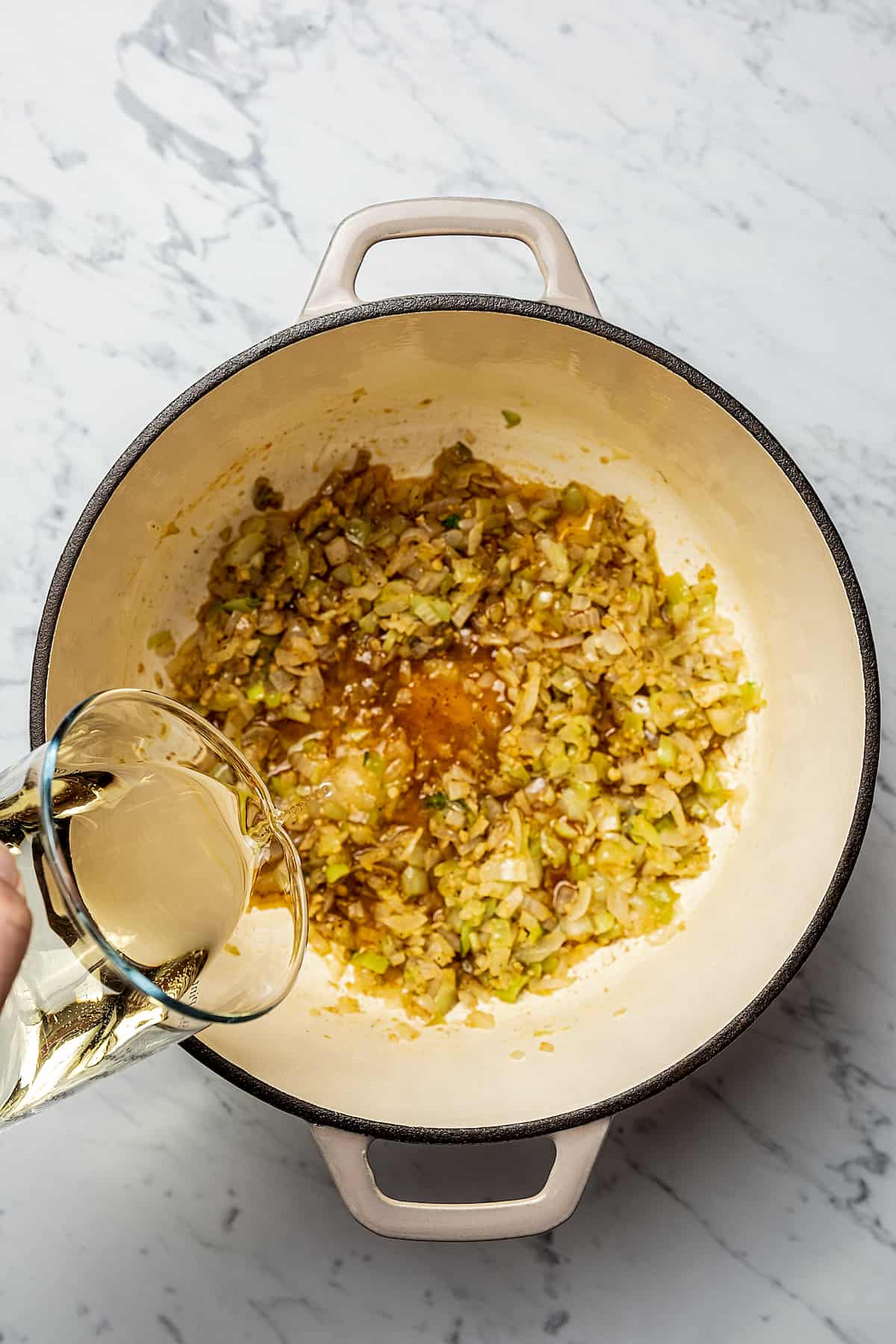
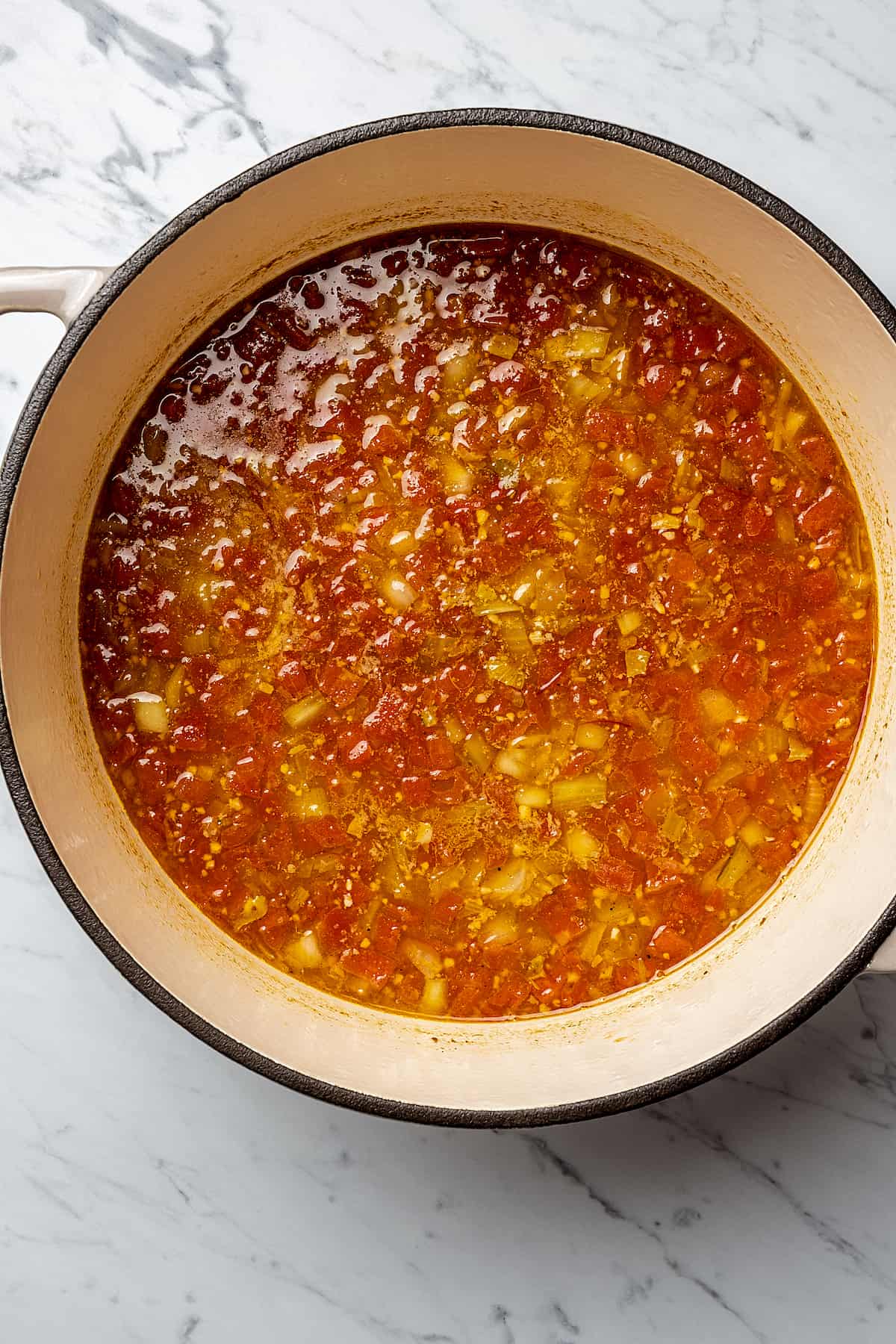
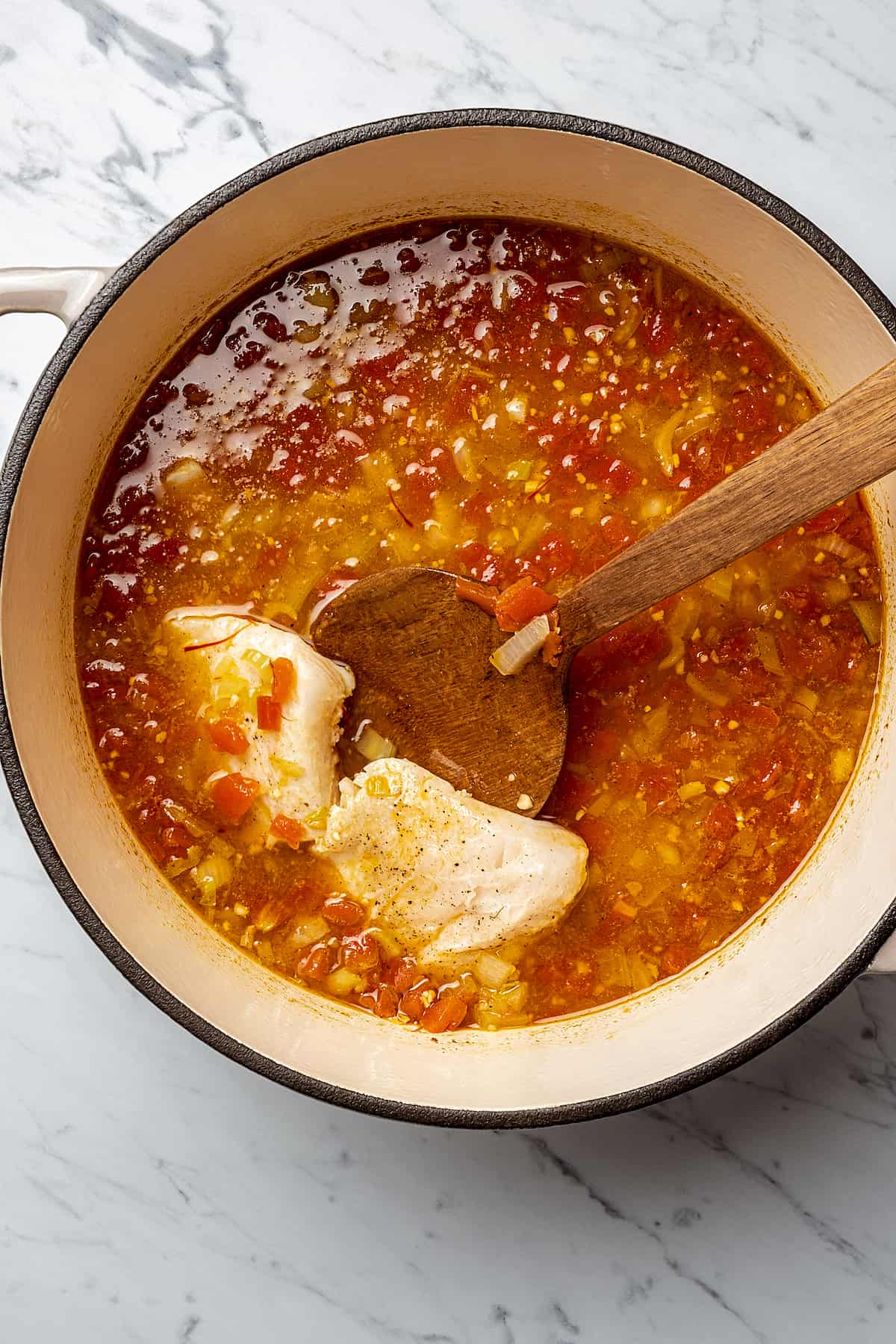
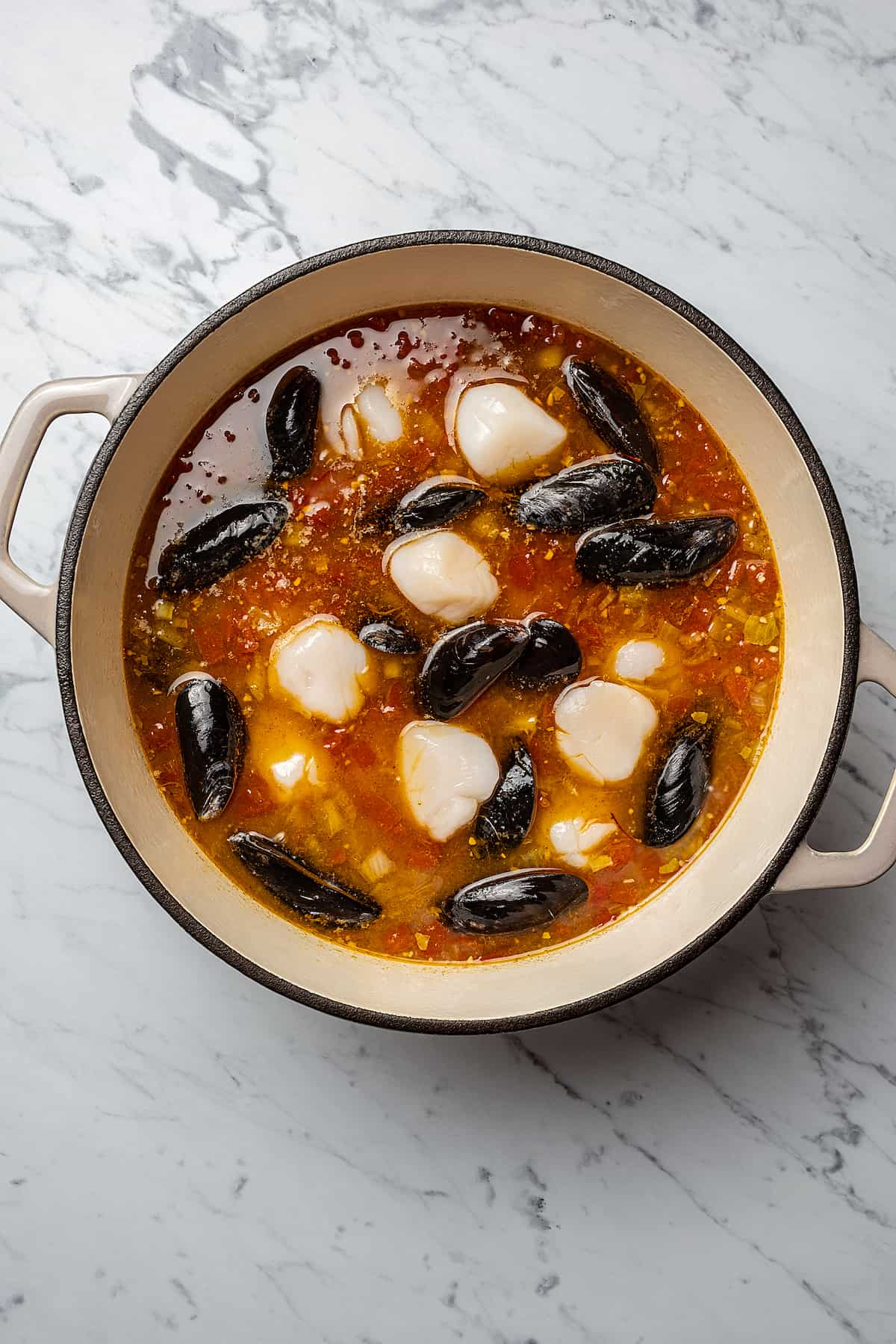
- Cook the Aromatics. Set a Dutch oven or soup pot over medium-high heat. Warm the olive oil and stir in the chopped fennel and onion. Cook them until they are softened. Stir in the garlic, thyme, paprika, saffron, and cayenne pepper, and let those cook for 20 seconds.
- Add the Liquids. Stir the white wine into the hot ingredients – it will bubble and steam. Let this cook down for a minute or so, stirring to scrape any browned bits off the bottom of the pot. Add in clam juice, undrained tomatoes, and bay leaves. Bring the soup to a boil before reducing the heat and letting it simmer for 10 minutes.
- Fish. Add your halibut pieces to the broth, cover, and cook over medium-low heat for two minutes.
- Add the Mussels and Scallops. Mussels and scallops are next – they need to be arranged in the simmering soup, cooked for three minutes, and covered.
- Add the Shrimp. Shrimp cook the quickest, so they go in last. Add the shrimp, cover the pot, and cook them for 2-3 minutes or until they are opaque and pink.
- Finish the Dish. Once the seafood is cooked, take the stew off the heat and discard the bay leaves and any unopened mussels. (Unopened mussels are considered unsafe to eat and should not be served.) Stir in the fresh basil and parsley, give the soup a taste, and add more salt and pepper as needed.
- Serve. Ladle your soup into bowls, and serve it with freshly toasted baguette slices.
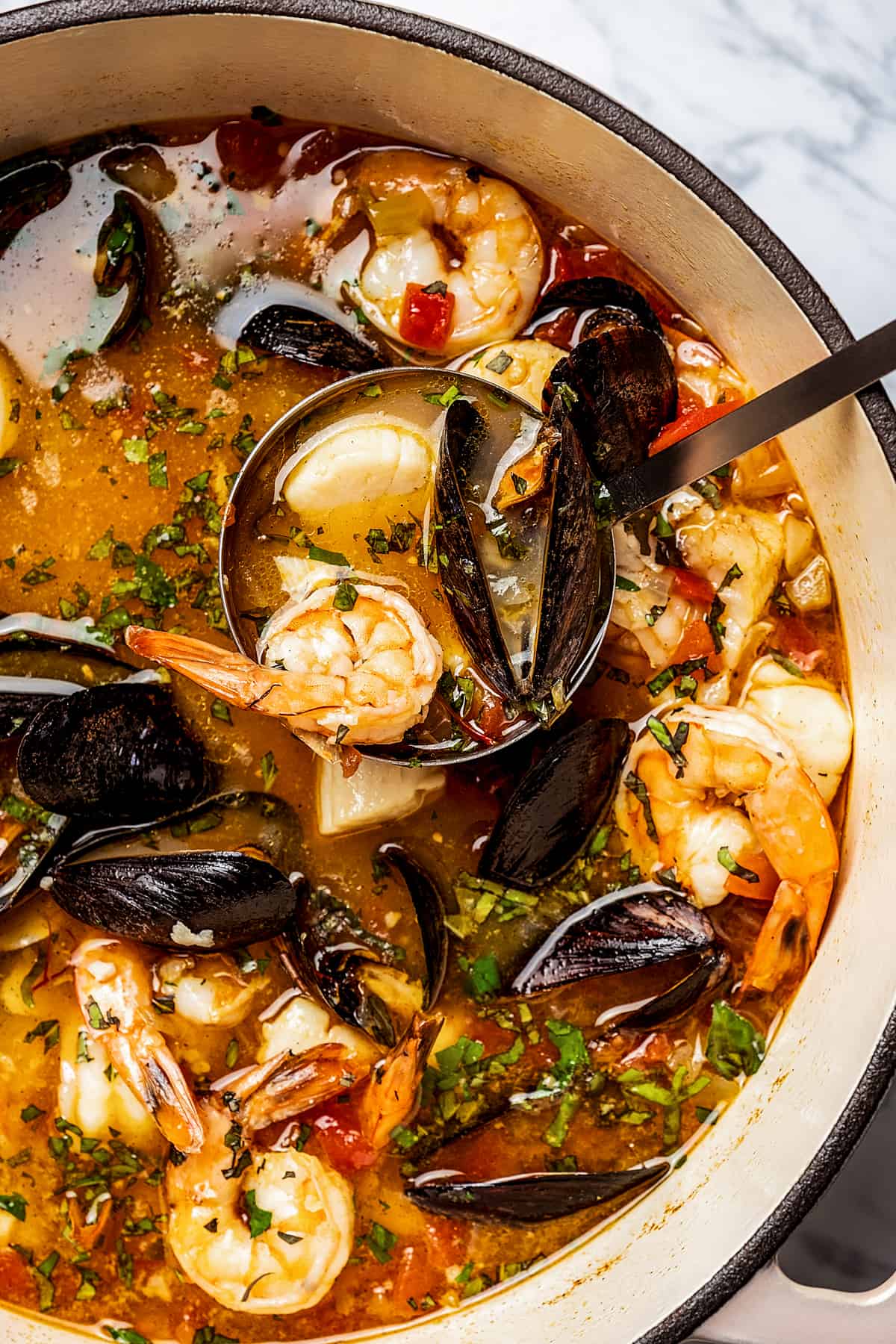
Tips and Tricks
- Wine-Free: Some cooks don’t want to add wine to their dishes, but don’t let that stop you from making an awesome bouillabaisse! Some great substitutes include chicken broth with a tiny bit of dijon mustard whisked in (dijon mustard has a distinctly wine-like taste) or water mixed with a bit of vinegar.
- Optional Flavor Boosts: You can stir a little tomato paste into the sauteing veggies for more depth of flavor – this is especially helpful if you’re not using wine in the dish. A little orange or lemon zest is also fabulous for giving bouillabaisse a nice lift.
- Fish Options: As you can see, I used a combination of firm, meaty fish, tender shrimp, sweet scallops, and mussels to get some variety in my bouillabaisse. However, you can make all kinds of substitutes here – remember, bouillabaisse was traditionally based on the day’s catch. You can use a combination of meaty, flaky, fatty, and lean fish, plus whatever shellfish you have (or no shellfish at all). If some of the fish “dissolves” while cooking, that’s okay! It will enrich the soup broth and taste delicious either way.
Which Is Better, Fresh or Frozen Fish?
You might think that the best fish comes from the fresh fish case at your grocery store, but that’s not necessarily true – sometimes, the highest quality is right there in the frozen section, just needing to be thawed out before use. Frozen fish is often frozen right at the peak of quality and then defrosted just before you’re ready to cook. The “fresh” fish behind the counter might be more convenient, but it has usually been frozen for transportation and then thawed at the store to sell. That fresh fish fillet you pick up may have been sitting around on ice for hours before you buy it, making it less “fresh” than seafood you thaw out in your own fridge.

Serving Suggestions
For me, this meal needs some crusty baguette slices and nothing else! However, if you’d like to round out the menu with a side dish or two, serve it with this Spinach Blackberry Salad for a summery, sweet side dish or this Broccoli Cauliflower Salad. Skip the baguette slices and make these Biscuits, or create a homemade artisan loaf in your slow cooker with this Slow Cooker Basil Pesto Bread. Stir Fry Zucchini Noodles or these Creamy Ricotta Zucchini Noodles work beautifully next to the rich broth in this soup. Bon appetit!
Storing and Reheating
- Store leftover bouillabaisse in an airtight container in the refrigerator for 3 days.
- To reheat, pour it into a saucepan set over medium heat and let it cook until the soup starts to simmer. Don’t overcook it; the fish and seafood will be dry and rubbery.
- To Freeze: Bouillabaisse can be frozen for up to three months. Cool the soup, remove mussels from their shells (discard the shells), and pour the soup into a freezer container, covering all the seafood with broth. Label with the date and freeze. Thaw in the fridge before reheating.
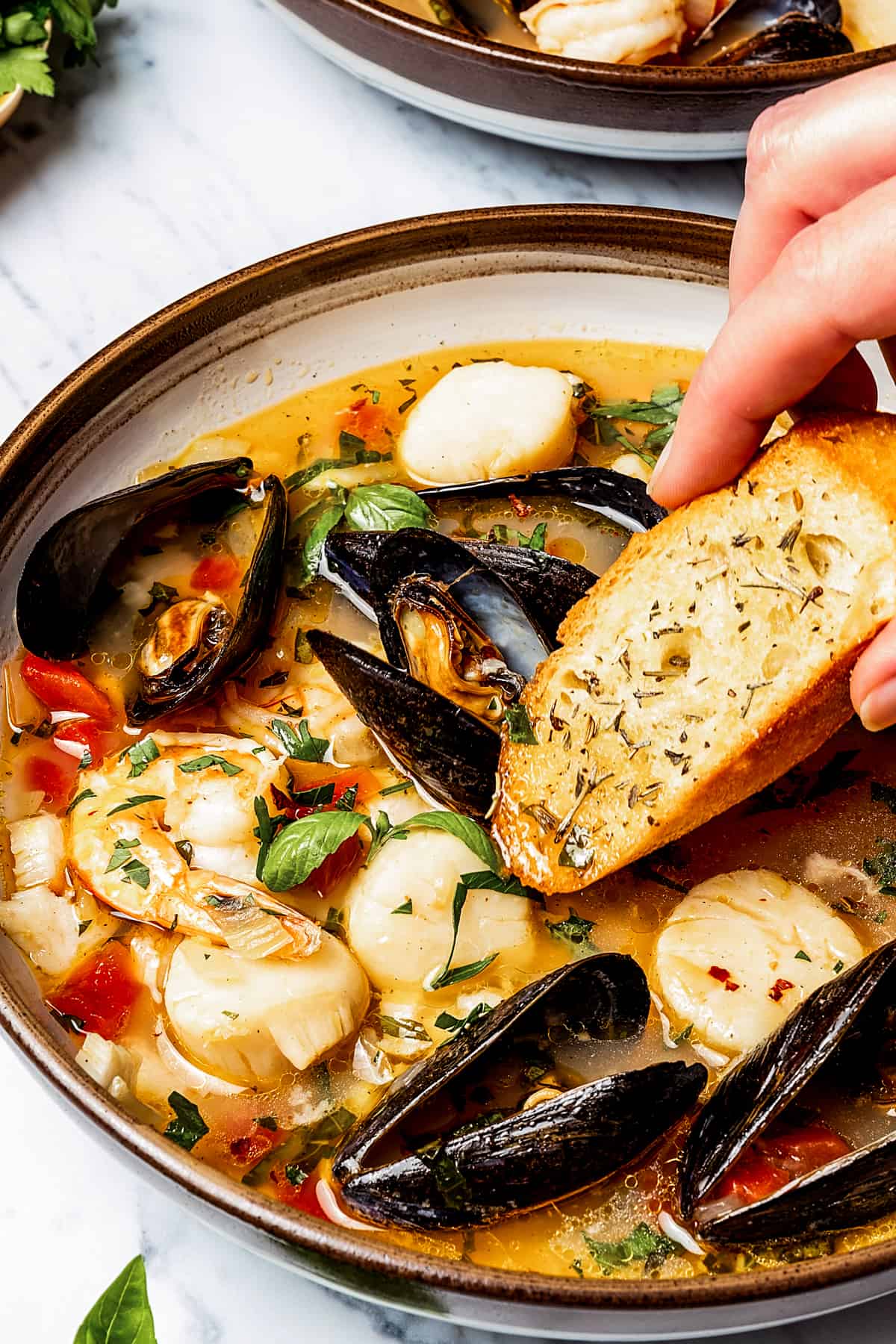
More Seafood Dishes
- Spanish Seafood Paella
- Honey Garlic Sauce Salmon
- Bang Bang Shrimp
- Seafood Boil
- Creamy Lobster Bisque
Pin this now to find it later
Pin It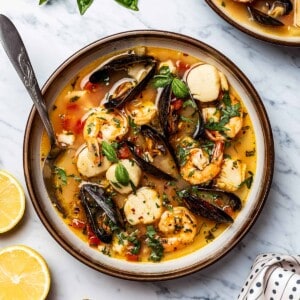
Bouillabaisse Recipe
Ingredients
- 3 tablespoons olive oil
- 1 tablespoon butter
- 1 fennel bulb,, cored and finely chopped
- 1 small yellow onion,, diced
- 8 cloves garlic,, minced
- ¼ teaspoon dried thyme
- ¼ teaspoon paprika
- ¼ teaspoon saffron threads
- ⅛ teaspoon cayenne pepper
- 1 cup dry white wine
- 4 cups clam juice,, seafood stock can also be used
- 14 ounces canned diced tomatoes, , undrained
- 2 bay leaves
- 1 pound halibut filets,, cut into 3-inch pieces
- salt and fresh ground black pepper,, to taste
- 12 ounces mussels,, scrubbed and debearded
- 1 pound sea scallops,, tendons removed
- 8 to 10 ounces raw shrimp,, peeled and deveined
- 2 tablespoons finely chopped fresh basil
- 1 tablespoon finely chopped fresh parsley
- red pepper flakes,, for garnish, optional
- baguette slices,, toasted, optional
Instructions
- Heat the olive oil and melt the butter in a large Dutch oven set over medium-high heat.
- Add the chopped fennel and onion and cook for about 5 minutes, or until softened. Stir frequently to prevent burning.
- Stir in the garlic, thyme, paprika, saffron, and cayenne pepper; cook for 20 seconds.
- Stir in the wine, scraping up all the browned pieces from the bottom of the pot, and cook for 1 minute.
- Add in the clam juice (or seafood stock), tomatoes with the tomato juices, and the bay leaves.
- Bring to a boil; reduce heat to medium and simmer for 8 to 10 minutes, or until the liquid has reduced by half.
- Season the halibut pieces with salt and pepper.
- Add the halibut to the pot; reduce heat to medium-low, cover, and cook for 2 minutes.
- Next, nestle in the mussels and scallops, cover the pot, and cook for 3 minutes.
- Remove cover; add in the shrimp, cover, and cook for 2 to 3 more minutes, or until shrimp is opaque, halibut is cooked through, mussels have opened, and scallops are firm.
- Remove from heat and discard bay leaves and any unopened mussels.
- Stir in the basil and parsley.
- Taste for salt and pepper and adjust accordingly.
- Ladle into wide bowls, garnish with red pepper flakes, if using, and serve with baguette slices.
Equipment
Notes
- Choosing Seafood: Mix firm fish, shrimp, mussels, and scallops for variety and a more authentic and delicious Bouillabaisse.
- Seasoning: Traditionally, Bouillabaisse is flavored with various herbs and spices, including saffron, garlic, and fennel. Don’t skimp on these – they make a significant difference to the end result.
- Don’t Rush: The flavors of a good Bouillabaisse come from slow cooking, which allows the flavors of the different types of fish and the herbs to meld together beautifully.
- If skipping the wine, use chicken broth with a dash of Dijon mustard or water with a bit of vinegar instead.
- Boost flavor: Tomato paste in sauteed veggies or citrus zest can enhance the taste, especially if you are not using wine.
Nutrition
Nutritional info is an estimate and provided as courtesy. Values may vary according to the ingredients and tools used. Please use your preferred nutritional calculator for more detailed info.
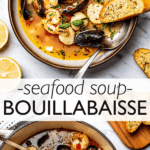








Can I use oysters also?
Sure! You can add those together with the fish.
Does using the fennel bulb give a black licorice flavor?
Hi!
It adds a very mild licorice flavor.
Love the double/triple measurements and substitutions
Excellent, used 1 bottle of wine and 1 cup of fish base stock to add more broth.
Can you make this ahead of time? Would like for our entree this Christmas but would like to have it done so I’m not cooking while guests are here
Hi!
I will preface this with some culinary advice: seafood soups are best if served immediately. However, if you have to make it beforehand, soups made with fish or shellfish should be refrigerated for at most 1 day. If using mussels, remove them from their shells before storing the soup, and discard the shells. Reheat the soup over medium-low heat, stirring gently and frequently.
cant wait to try it, love seafood, your recipes are great, thanks.
It’s easy, flavorful and healthy. I’ve already made it twice and picking up shrimp at the farmer’s market to make it again.
That’s great! I’m very glad you enjoyed it! Thank YOU! 🙂
Easy, tasty & not costly to make. Substituted halibut for rock cod & added clams.
I hope you enjoy it! Thank YOU! 🙂
This recipe is so perfect I would not change any of the measurements. It’s very perfectly balance in all ways; tomatoes flavor, wine, spicy-nest, clam juice. I was so scare of all the clam juice and wine, but girl/boy I was wrong. This will go into my repertoire.
Oh, and so easy to make!
Going to try this later on in the week when I buy the remaining ingredients on my list! Have to do without the cup of wine since I’m 3 years sober and don’t feel comfortable buying alcohol. Hopefully broth and a little vinegar will be suffice to deglaze the pan.
I hope you’ll enjoy it! Thank YOU! 🙂